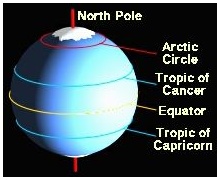
 Hold On at the Equator - Relax at the Poles The Arctic Circle is one of the five major circles of latitude that mark maps of the Earth. The area north of this imaginary line (at about 66°33' north of the Equator) is known as the Arctic, and the zone just to the south of this circle is the Northern Temperate Zone. The Arctic Circle marks the start of the area where, for at least one day each year, the sun does not completely set (June 21) or rise (December 22). The circumference of the Earth at the Equator is 24,902 miles / 40,075 km. It spins around once every 24 hours, so if you are standing on the Equator you are actually moving at about 1,037 mph / 1,669 kph. Standing on the Arctic Circle, the distance around the Earth is reduced to about 10,975 miles / 17,662 km. This would slow you down to 457 mph / 736 kph. And... if you're standing right on the North Pole, you're not moving at any speed at all. You're just spinning around on one spot - very, very slowly (like one turn every 24 hours). The planet Earth is not a perfect sphere. This spinning seems to have had the effect of making the planet "bulge" around the Equator and be slightly flatter at the poles. As well, the circumference taken pole-to-pole would be 24,860 miles / 40,008 km - a slight decrease in distance.
|

|
DICTIONARY: Just "double-click" any unlinked word on this page for the definition from Merriam-Webster's Student Electronic Dictionary at Word Central. |

|
ARCTIC LIBRARY & GLOSSARY: Check this section for an index of the rest of the things you really need to know about the Arctic. |

|
ARCTIC MAPS & WEATHER REPORTS: Maps of the Northwest Passage, explorers' routes, iceberg sources, Nunavut, the Arctic by treeline, temperature... |

|
ARCTIC LINKS: Even more information! Links to sites related to the Arctic and "Iceberg: the Story of the Throps and the Squallhoots". |

|
GUIDE TO ARCTIC SUNRISE & SUNSET: How much sunlight or darkness is there in the Arctic on each day of the year? |
to is the property of their respective owners, and Athropolis is not responsible for their content.
